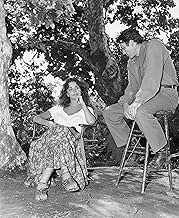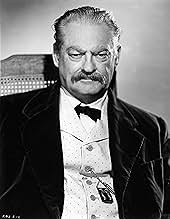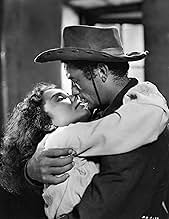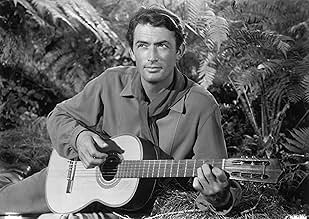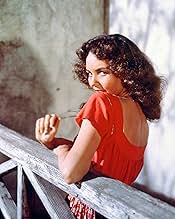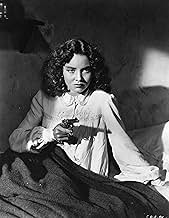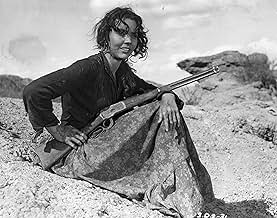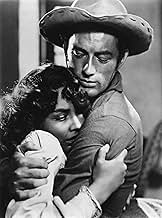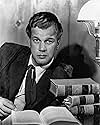CALIFICACIÓN DE IMDb
6.7/10
10 k
TU CALIFICACIÓN
La hermosa mestiza Pearl Chávez se convierte en pupilo del primer amor de su padre muerto y se encuentra dividida entre los hijos de esta, uno bueno y el otro malo.La hermosa mestiza Pearl Chávez se convierte en pupilo del primer amor de su padre muerto y se encuentra dividida entre los hijos de esta, uno bueno y el otro malo.La hermosa mestiza Pearl Chávez se convierte en pupilo del primer amor de su padre muerto y se encuentra dividida entre los hijos de esta, uno bueno y el otro malo.
- Nominado a 2 premios Óscar
- 3 premios ganados y 4 nominaciones en total
Griff Barnett
- The Bordertown Jailer
- (sin créditos)
John Barton
- Party Guest
- (sin créditos)
Opiniones destacadas
Released in 1946 and directed by King Vidor, "Duel in the Sun" stars Gregory Peck and Joseph Cotton as two rival sons of a ranch baron (Lionel Barrymore) in West Texas in the 1880s. When a striking half-breed (Jennifer Jones) comes to live on the ranch, she inspires love in the mild-mannered, educated son (Cotton) and unpredictable lust in the mocking, wild one (Peck). Lillian Gish plays the mother stuck in the middle while Walter Huston appears as a semi-questionable minister known as The Sinkiller. Charles Bickford is on hand as an older man also interested in the drama mama.
While the movie runs 2 hours and 24 minutes, a full 16 minutes is opening and ending music, which makes the runtime of the story itself just over 2 hours. Speaking of the opening "Prelude" and "Overture," the music (by Dimitri Tiomkin) is thoroughly passé and goes on way too long at 12 minutes before the credits, which last another 1:35. If you can get past that, though, this is a great old Western where the producers pulled out all the stops to entertain. Producer, writer and (uncredited) director David O. Selznick's ambition was to top "King Kong" (1933) and, particularly, "Gone with the Wind" (1939), two other pictures he produced.
Although critics fittingly dubbed it "Lust in the Dust," the movie WAS popular with the masses, no doubt helped by its controversial sexual content (which is tame today) and Selznick's affair with Jones, which broke up both of their marriages. They got married a few years later and it lasted till his death in 1965. Despite its box office success, "Duel" couldn't top "Gone with the Wind" and, being the most expensive film ever made at that point, it only broke even, although it eventually went on to make a profit with a re-release in 1954, etc.
Jones is notable as the heavy-breathing babe, but I personally prefer Joan Tetzel as the fiancé of the older son (Cotton). Also, Peck plays the bad son surprisingly well, considering how he's known for playing more noble protagonists, e.g. "The Big Country" (1958) and "Mackenna's Gold" (1969).
Bottom line: "Duel in the Sun" was just too big of a production to lose. Its story, while decidedly melodramatic, is compelling from beginning to end and there are highlights spiced throughout, including some stunning cinematography, amusing moments with horses and a couple of almost shocking sequences and story turns (e.g. the shootout in the saloon and, later, on the town street). To be expected, there are also some lowlights, but the movie always quickly recovers and maintains its footing. Lastly, there's a valuable moral hidden within the Western soap operatic shenanigans.
The film was shot in Arizona & California (too many places to list). The script was written by David O. Selznick & Oliver H.P. Garrett (and, uncredited, Ben Hecht) suggested by a novel by Niven Busch. ADDITIONAL CAST: Herbert Marshall, Harry Carey, Scott McKay & Butterfly McQueen.
GRADE: A
While the movie runs 2 hours and 24 minutes, a full 16 minutes is opening and ending music, which makes the runtime of the story itself just over 2 hours. Speaking of the opening "Prelude" and "Overture," the music (by Dimitri Tiomkin) is thoroughly passé and goes on way too long at 12 minutes before the credits, which last another 1:35. If you can get past that, though, this is a great old Western where the producers pulled out all the stops to entertain. Producer, writer and (uncredited) director David O. Selznick's ambition was to top "King Kong" (1933) and, particularly, "Gone with the Wind" (1939), two other pictures he produced.
Although critics fittingly dubbed it "Lust in the Dust," the movie WAS popular with the masses, no doubt helped by its controversial sexual content (which is tame today) and Selznick's affair with Jones, which broke up both of their marriages. They got married a few years later and it lasted till his death in 1965. Despite its box office success, "Duel" couldn't top "Gone with the Wind" and, being the most expensive film ever made at that point, it only broke even, although it eventually went on to make a profit with a re-release in 1954, etc.
Jones is notable as the heavy-breathing babe, but I personally prefer Joan Tetzel as the fiancé of the older son (Cotton). Also, Peck plays the bad son surprisingly well, considering how he's known for playing more noble protagonists, e.g. "The Big Country" (1958) and "Mackenna's Gold" (1969).
Bottom line: "Duel in the Sun" was just too big of a production to lose. Its story, while decidedly melodramatic, is compelling from beginning to end and there are highlights spiced throughout, including some stunning cinematography, amusing moments with horses and a couple of almost shocking sequences and story turns (e.g. the shootout in the saloon and, later, on the town street). To be expected, there are also some lowlights, but the movie always quickly recovers and maintains its footing. Lastly, there's a valuable moral hidden within the Western soap operatic shenanigans.
The film was shot in Arizona & California (too many places to list). The script was written by David O. Selznick & Oliver H.P. Garrett (and, uncredited, Ben Hecht) suggested by a novel by Niven Busch. ADDITIONAL CAST: Herbert Marshall, Harry Carey, Scott McKay & Butterfly McQueen.
GRADE: A
This movie is like a painting by an old master that hangs in a museum--we may not be moved by it, but we can still appreciate the artistry. Its most notable feature is the director, King Vidor, master of silent film making. As you might expect, many of the important scenes have little or no dialog. In one scene between Lionel Barrymore and Lillian Gish, he rambles on about their life together, while she strains to get out of her sickbed and crosses slowly to him, the entire distance transfigured by the depth of her love for him. Gish was a great star of silent film, with a wonderful, expressive face, full of compassion and grace. In another scene that happens under quite different circumstances, Jennifer Jones crawls to Gregory Peck, the man she loves, also without words, evincing great sorrow and quiet dignity. In both cases, the women prove they are far more noble than the men who love them so badly. Jones also has a mobile face, together with a beautiful, resonant voice. No film that has these two ladies at its center should be missed. In addition, the film has two marvelous scenes that, at the time of its making, would have been just as impressive as some of today's special effects wonders: In the first, about 20 armed horsemen face a crowd of railway workers, including some chinese, clothed in authentic period dress, with a steam engine in the background. As the tensions mount, a troop of mounted cavalry, about 100 strong, ride onto the set, filmed on location (judging by the saguarros and ocatillos) in Arizona. This was a tour de force of filmmaking at a time when shooting on location was rare. In the second scene, a train under a full head of steam jumps the tracks and plows down an embankment. Filmed in early technicolor, this movie has lush exteriors and panoramas of rich desert color. Two more character actors should be mentioned, both of whom steal every scene they enter: Butterfly McQueen, the maid whose comments are both simple and profound, and Walter Huston, as the crusty sheriff who doubles as a preacher during a funeral.
not great. only perfect. for the story, mix of different lines. for cast. and for the meet between Jennifer Jones and Gregory Peck in a last scene who impress again and again. it is a masterpiece . for the opportunity to discover a lost age of Hollywood in the best version. for the desire, and the reasonable result, to make a different western. and for its...humanitarian perspective about love and family. sure, I am far to be objective about it as admirer of Lillian Gish and Gregory Peck . but it is real good film. maybe, obvious, perfect.
Well, it's obvious that Selznick was trying his best to recapture that GWTW magic...but this is an unbelievably inept failure. Here's what you can expect from this overblown sex-western:
--Jennifer Jones (in pancake make-up so orange that she put me more in mind of an Oompa-Loompa than the half-breed we're supposed to see) apparently directed to act as though she's Scarlett O'Hara with a lobotomy and bad grammar.
--Gregory Peck as rogue murdering rapist and the apple of his daddy's eye. At one point even doing a pretty decent vocal imitation of Clark Gable -- too bad it's just the voice.
--Lionel Barrymore lazily repeating his "It's a Wonderful Life" role from the same year -- wheelchair & grumpiness standing in for effort.
--Butterfly McQueen as kerchiefed ditzy maid. Hmmm, wonder where they got that idea?
All in all, a miserable movie experience. You'd think that since they cribbed from the best it'd have turned out better! Go figure.
--Jennifer Jones (in pancake make-up so orange that she put me more in mind of an Oompa-Loompa than the half-breed we're supposed to see) apparently directed to act as though she's Scarlett O'Hara with a lobotomy and bad grammar.
--Gregory Peck as rogue murdering rapist and the apple of his daddy's eye. At one point even doing a pretty decent vocal imitation of Clark Gable -- too bad it's just the voice.
--Lionel Barrymore lazily repeating his "It's a Wonderful Life" role from the same year -- wheelchair & grumpiness standing in for effort.
--Butterfly McQueen as kerchiefed ditzy maid. Hmmm, wonder where they got that idea?
All in all, a miserable movie experience. You'd think that since they cribbed from the best it'd have turned out better! Go figure.
Well, it's no Gone With The Wind. Selznick, again, features his wife, Jennifer Jones, in a different role than the usual wholesome roles she was expected to do. Portrait Of Jennie, Since You Went Away and Song of Bernadette. Jones has a bad habit of over-acting if allowed to do so. Example is Tender Is The Night, Man In A Grey Flannel Suit, Ruby Gentry and Love Letters. It takes a strong director to tone her down. King Vidor lost control of her in this or Selznick had too much control. Her performance consisted of a low gutteral voice and a sashaying walk. Not much else.
On the other hand, excellent supporting roles were played by Lionel Barrymore and Lilian Gish. They stole the picture in this viewer's opinion. Gregory Peck and Joseph Cotton went through the paces of what they were asked to do as rivalry brothers. But you kind of knew their hearts weren't in it. Then there was the presence of Butterfly McQueen in her usual Gone With The Wind type performance. Charles Bickford in an undistinguished role was wasted as was Herbert Marshall and Sidney Blackner [all good actors]. An impressive cast when the titles came on, but what followed was not what you wanted to see.
I got tired of seeing Jennifer Jones strutting about making faces of some indian half-breed. Boring. Oh, I liked the horse [the pinto] that she rode. He was terrific. Best to see this on video. Doesn't come off that bad. But it is a cornball western farce.
On the other hand, excellent supporting roles were played by Lionel Barrymore and Lilian Gish. They stole the picture in this viewer's opinion. Gregory Peck and Joseph Cotton went through the paces of what they were asked to do as rivalry brothers. But you kind of knew their hearts weren't in it. Then there was the presence of Butterfly McQueen in her usual Gone With The Wind type performance. Charles Bickford in an undistinguished role was wasted as was Herbert Marshall and Sidney Blackner [all good actors]. An impressive cast when the titles came on, but what followed was not what you wanted to see.
I got tired of seeing Jennifer Jones strutting about making faces of some indian half-breed. Boring. Oh, I liked the horse [the pinto] that she rode. He was terrific. Best to see this on video. Doesn't come off that bad. But it is a cornball western farce.
¿Sabías que…?
- TriviaAccording to King Vidor, director Josef von Sternberg was hired only as a lighting expert by David O. Selznick in order to give his wife--and the film's star--Jennifer Jones a more glamorous look.
- ErroresThe opening shows saguaro cacti in the valley. The film is supposed to take place in Texas, but southern Arizona is the only place in the US with saguaro cacti, unless they've been transplanted.
- Citas
The Sinkiller: Under that heathen blanket, there's a full-blossomed woman built by the devil to drive men crazy.
- Versiones alternativasThe original "roadshow" version ran 144 minutes. The additional 16 minutes, over the commonly-shown 128 minute version, consisted of a musical "prelude," an "overture" (which contained a spoken prologue, by Orson Welles), and exit music, but no additional scenes in the film. The two additional opening sequences were each inadvertently given the other's label.
- ConexionesEdited into Histoire(s) du cinéma: Une histoire seule (1989)
Selecciones populares
Inicia sesión para calificar y agrega a la lista de videos para obtener recomendaciones personalizadas
Detalles
- Fecha de lanzamiento
- País de origen
- Idioma
- También se conoce como
- Duel in the Sun
- Locaciones de filmación
- Productoras
- Ver más créditos de la compañía en IMDbPro
Taquilla
- Presupuesto
- USD 8,000,000 (estimado)
- Total en EE. UU. y Canadá
- USD 20,408,163
- Total a nivel mundial
- USD 20,428,771
- Tiempo de ejecución
- 2h 26min(146 min)
- Relación de aspecto
- 1.37 : 1
Contribuir a esta página
Sugiere una edición o agrega el contenido que falta


